 Facebook
Facebook
 X
X
 Instagram
Instagram
 TikTok
TikTok
 Youtube
Youtube
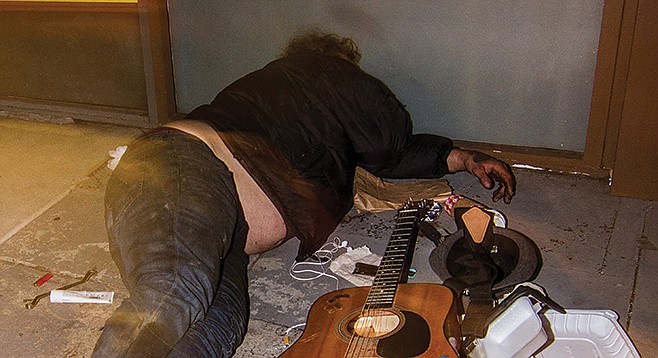
To some, Hillcrest is little more than 40 acres of overpriced, rambling urbanity to be avoided. Such Hillcrest-averse see two problems: scarce parking, and a homeless crisis that seems “worse than Ocean Beach.”
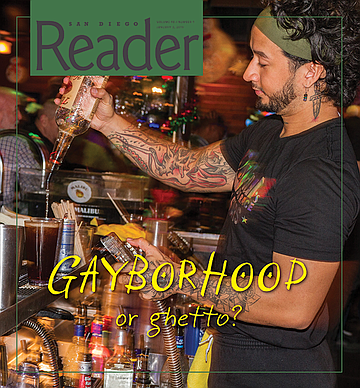
“Currently the biggest misconception about Hillcrest is that there’s no parking,” counters Lukas Volk, a community advocate in his personal life and marketing and communications director at Mo’s Universe, the parent company of Urban Mo’s, Baja Betty’s, Gossip Grill, Inside Out, and Hillcrest Brewing Company — all of which are in Hillcrest.
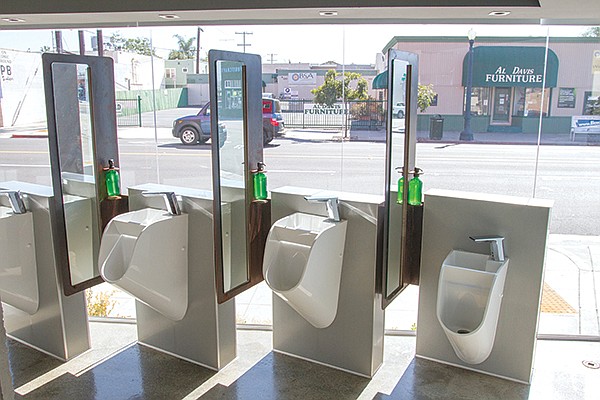
“There’s plenty of free parking in Hillcrest,” Volk, seated in one of Mo’s big red booths during a recent daytime interview, says with a sly grin. “It’s hiding at the DMV!”
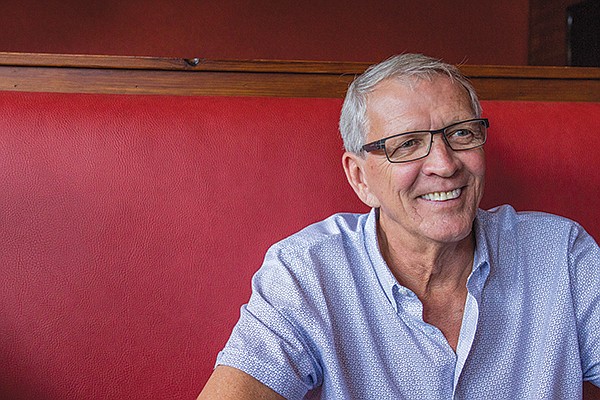
Free parking from 6:30 pm to 3 am at the Department of Motor Vehicles parking lot at 3960 Normal Street is real. But the Hillcrest Parking District’s official website notes that the lot, a couple of blocks north of Hillcrest’s University Avenue business district, is closed on Tuesday and Thursday nights.
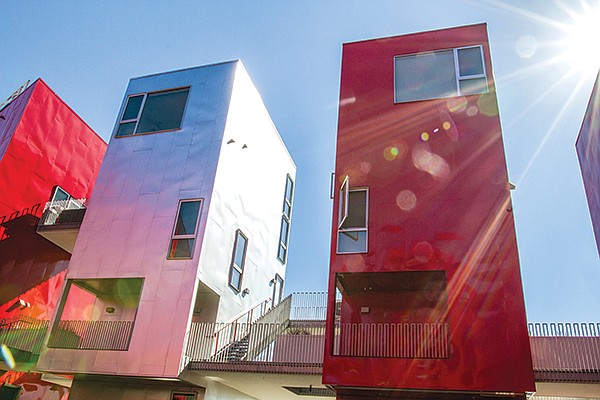
Even so, it would probably take more than free parking or even an end to homelessness to change the minds of those not already invested in a community whose heart is at Fifth Avenue and Robinson Street, but whose soul is somewhere between eccentric and, well, queer.
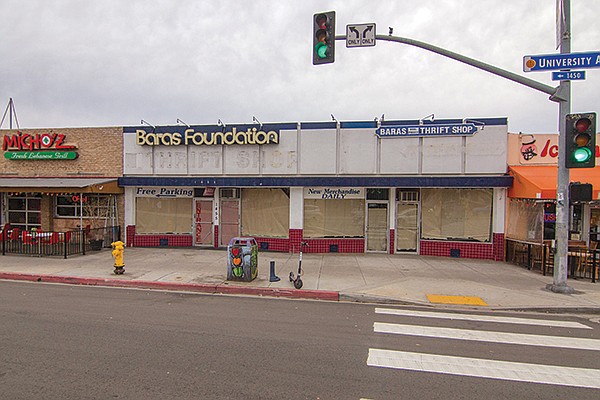
More wholesome than West Hollywood, you say?
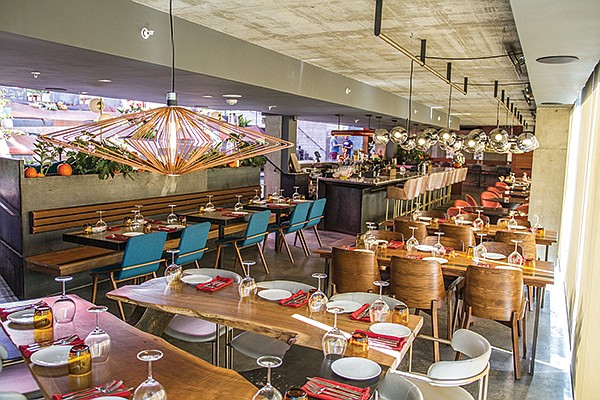
Hillcrest is a magnet to young lesbian, gay, bi, transgender, queer and questioning people from the local region and from all corners of the America. They arrive in San Diego’s “gayborhood” hoping to have their rainbow layer cake and eat it too. Many come to Hillcrest believing they’ve outsmarted their admonishing kin back in Peoria, Okaloosa, or even Poway.
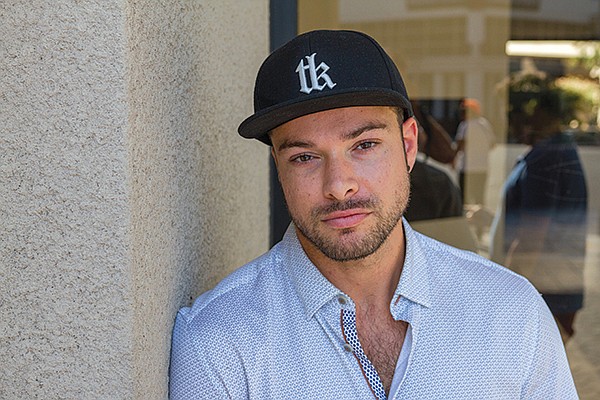
Some have been warned they risk getting mired in the decadence of sordid places such as Hollywood or San Francisco, where ultimately they’ll die alone as a result of their “lifestyle choice.”

So, they come to Hillcrest.
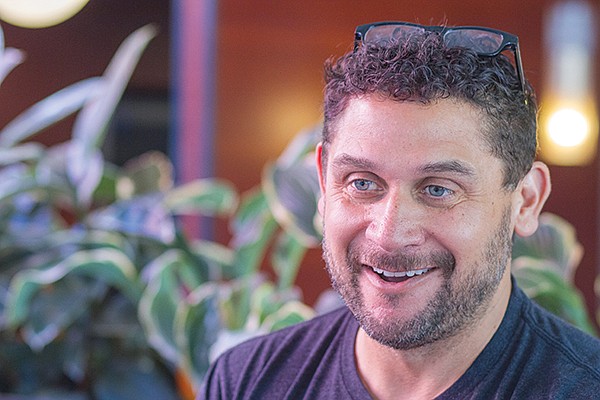
“I still love Jesus, and I’m still a conservative,” Texana R., 17, tells me. “I just am — I don’t care what my mama or my aunt or my step sister or no one else says. I might be transgender, but I am also a family-values person. I don’t want to live in West Hollywood or San Francisco.”

Texana is a name the relatively new Hillcrest resident has taken since arriving here. Texana admits to being “technically homeless.” Yet the young Hillcrest transplant claims not to have had to actually sleep outdoors more than a few nights during the nearly five months since arriving here from a southern state Texana asked we not mention because… “I’m technically — I guess you’d say — a runaway. I will be 18 in 2019. On my birthday, my present to myself and to my mother is going to be that I’m going to call her and tell her where I am.”

However devoutly evangelical — and allegedly brutally homophobic and transphobic — Texana says “Mama” is, she did not make her child leave home. “I left because Mama couldn’t ask me to leave,” the young Southerner explains.

“I was afraid she was going to take me and she would leave him — my step daddy. He was making her cry day every day. He and me would yell and fight all the time. He calls me ‘thing’ or ‘that thing.’ It was killing my mother. She can’t afford to leave him. We was homeless before they got married. He keeps her on the straight-and-narrow.”
Laughter explodes from Texana’s cherubic face. It’s the only time during our 45-minute chat at The Hub when he laughs.
(“The Hub” shopping district on University between Vermont and 10th Avenues, anchored by a Ralphs grocery, teems with activity at any time of day or night. It’s a melting pot of shops, eateries, bars, local gentry, homeless society, and championship-level parking competition.)
“Straight-and-narrow!” Texana repeats. “That’s ironic. Mama wants me to be straight and narrow-minded like her. But I want her to stay with that narrow-minded asshole husband, because he keeps her off them opioids and that meth. Oh yeah, they’ve got religion back home. But they got some other stuff too.”
“But why come to Hillcrest, specifically?” I ask again.
“I like the people. I like the military. I’m going to join the Marines. Soon as I’m 18, next year. I’m a born Marine, just like my brother. The day I turn 18, I’m going down there to that recruiting station. I’ve practiced taking the trolley. I talked to the guys.”
Texana believes that Hillcrest is somehow more wholesome, at least superficially, than some other LGBTQ-identified communities along the West Coast. Texana’s not the only one. There’s an old adage in the community: “West Hollywood is where you go to hook up. Hillcrest is where you go to settle down.”
To be or entropy?
Locked in a decades-old battle between entrenched, no-growth zealots and land-lusting developers, San Diego’s gayborhood has evolved, in concrete terms, via slow, incremental renewal that’s been interrupted by spastic jolts of new-building flurry. Benjamin Nichols, executive director of the Hillcrest Business Association, leads an increasingly assertive and unapologetically pro-developer phalanx of local business leaders determined to end what they see as needless decay in Hillcrest.
“There are many examples that show that being aggressive concerning development in Hillcrest has been successful,” Nichols says. “Projects like 111 Robinson, Mr. Robinson at Robinson and Park, and the Eitol Towers are all examples where creating a positive environment for developers leads to positive projects.”
Love it or hate it, Eitol Towers is inarguably the most striking new building project to hit Hillcrest in a generation. Thirteen mixed-use minimalist-cubist towers jut vertically out of the sidewalk and streets below, reaching defiantly from a tight urban lot bounded by University Avenue, Harvey Milk, and Centre Streets.
Optically, the 13 towers appear even more massive than they are , because of the way 12 of the edifices are finished. They are wrapped all the way around in gleaming, fire engine-red cladding. The 12 red towers are cast against a 13th silvery, aluminum veneer. All 13 buildings pop in brilliant contrast (on a clear day) against blue San Diego skies. As a piece of architecture, Eitol — which is “Lot 13” backwards if you think of the “E” as a “3” — is designed to prompt your eyes to look skyward.
“Most people are calling it ‘The Red Building,’ of course,” says Matthew Ramon. Ramon is the main owner (among a partnership of owners) of Inside Out, a hyper-stylized lounge in residence at Eitol Towers’ street-level, storefront space.
Open less than a year, Inside Out is already famous citywide for its rakish décor, craft cocktails, and epicurean plates, but maybe most of all for its street-facing, windowed restrooms, with urinals that are essentially visible from the sidewalk, and yet provide just enough modesty paneling to keep things G-rated on the outside and indoors, too.
“It’s the newest building in Hillcrest that’s a real architectural statement,” Ramon says. “The idea from the architect, Mike Burnett, was to have one tower, the 13th, stand out in silver against the other 12 red towers. That represents the LGBTQ community standing out, as we tend to do. Meanwhile the red buildings themselves are meant to represent Hillcrest itself standing out as a neighborhood among the nearby communities.”
Hillcrest Business Association’s Benjamin Nichols says Eitol was made possible despite developers having been “scared away from Hillcrest” for fear of having to factor the costs of “frivolous lawsuits and [California Environmental Quality Act] abuses” into their projects’ budgets.
“This ‘Hillcrest tax’ drives developers to other neighborhoods,” he explains. “By aggressively supporting creative developers and letting them know that there are many in Hillcrest who support ‘Little Italy-style’ development, we have created an environment where creative developers are comfortable taking a risk on Hillcrest.”
Nichols says more major changes are coming soon to Hillcrest.
“Normal Street, Park Boulevard, and University Avenue itself will transform many of Hillcrest’s blighted blocks into beautiful places for people to live and play,” he says.
But in 2016, Nichols was widely criticized for issuing pro-developer planning recommendations to the city of San Diego, thus “sidestepping” the Uptown Planners group, which traditionally makes influential recommendations to the City. Uptown Planners’ recommendations cover proposed development in the Hillcrest-Uptown neighborhoods, as well as Mission Hills, Bankers Hill, and University Heights.
Rather than shrink from the accusations, Nichols owned the characterization that he was “sidestepping” Uptown Planners.
Emboldened by support from a group of influential, local business owners and developers and from his own board, Nichols believes he’s fighting entropy that for decades he says has been forced onto Hillcrest by a group of residents who he says want no growth in density or building heights in the neighborhood whatsoever.
Why, other than enabling his developer friends to build more stuff and make more money, does Nichols think more density is a good thing for Hillcrest?
“This will reduce our need for parking, and the development will revitalize our older infrastructure,” Nichols says. “This is exactly what has occurred over the last 20 years in Little Italy. Thousands of people support the business association’s vision for the future of Hillcrest.”
Hillcrest slow-growth activist, frequent Nichols critic, and Uptown Planners board member Matt Wahlstrom has often said that the Hillcrest Business Association and allies such as the Hillcrest Gateway Association want to force fundamentally out-of-character changes onto his beloved neighborhood.
“What these people want is the farm and the sky and everything in between,” he said in an interview with Ken Williams, formerly editor at Gay San Diego.
Hillcrest’s human capital used to yield an amalgam of hopes, dreams, and ideals that materialized as local art, as a neighborly state of mind, and in social and political expressions that once shaped San Diego’s culture far beyond Fifth and University Avenues. Now, say some locals, that same energy is turning into a fight between Hillcrest’s haves and the have-nots.
“I have lived in San Diego for more than five decades,” says San Diego City Commissioner Nicole Murray Ramirez. “Hillcrest was once a very artistic, welcoming, proud neighborhood.”
Ramirez says economic violence is killing Hillcrest. “Rent has skyrocketed,” he says. “It’s too much for working people and small business owners, gay or straight. People are moving out. The homeless problem is out of control. There are empty stores all over the place.”
It’s a harsh and direct indictment about the current quality of life in a neighborhood of which Ramirez was named “honorary mayor for life” by former interim San Diego mayor, now Assemblyman Todd Gloria.
“We need to make rent control and homelessness this city’s number-one priority,” Ramirez says. “Indeed, rent control needs to be California’s top priority.”
According to Ramirez, Hillcrest is turning into a “little ghetto where wealthy people look down from the big windows of their expensive glass condos at empty stores and vacant commercial buildings while desperate, hungry homeless people circle below, pushing all of their belongings around in grocery carts.”
Anti-gay confrontations
Hillcrest is a far cry from the 40 acres of pastoral land which William Wesley Whitson purchased — and later subdivided — from a large estate in University Heights in 1907.
In his 1999 article, Michael E. Dillinger describes the late 1960s and early 1970s as a period of transition when Hillcrest transformed from a near-wasteland of dying, postwar shopping centers and increasingly dilapidated single-family homes, to a safe haven for gay and lesbian San Diegans escaping hostility in other neighborhoods.
“Hillcrest from the early 1960s through the early 1970s allowed for affordable rent-space, a social scene otherwise impossible in a more up-scale community... The investment of the gay community in itself has brought Hillcrest from isolated obscurity to its status as one of the premiere commercial and social scenes in San Diego,” Dillinger wrote.
According to Dillinger, there’s a surprisingly simple reason why gay and lesbian people first colonized Hillcrest. “One of the main reasons for the scarcity of pedestrian and street traffic in Hillcrest as compared to downtown was the fact that such a high percentage of the population of Hillcrest was so elderly. This reduced street activity meant less opportunity for anti-gay confrontations. Avoiding physical clashes with those outside of the gay community was important to the fledgling gay movement.”
Should we call it Shawcrest?
Few people alive today are as closely associated with success in Hillcrest as Chris Shaw.
“We moved to San Diego from Maine when I was nine,” says Shaw, president of Mo’s Universe. “Mom and Dad got into a fight and San Diego was as far from Maine as she could drive.”
Coming to San Diego with his mom and two siblings was a fortuitous turn of events for Shaw. The mark he’s made on Hillcrest and the San Diego business and philanthropic communities is indelible. Just about anyone who’s every tried to get anything worth pursuing done in Hillcrest has probably gotten a helping hand from Shaw and company at some point. But it’s hard to get Shaw to acknowledge his own beneficence. That doesn’t stop others.
“It can sound kind of like we’re repeating it again and again, but we see it as our business to give to the community because we are the community,” says Volk, Shaw’s director of marketing and communications. “It would never occur to us to not do that. Chris is very clear that the community is our responsibility.”
But Shaw is the first to admit that his love affair with Hillcrest started out as fun. “I came out as gay when I was 18,” he recalls. “There were already gay bars here in Hillcrest. There was the Brass Rail, which was the main staple. But there were also 18-and-over clubs. That’s where I went before I turned 21. There was Basin Street, which was 18-and-over. It’s where the credit union is now on Fifth and University — well right behind there, where they have parking now. It was a place where you could go where there was dancing and music. It was a lot of fun.”
Mo’s recently launched its own 18-and-over night. But, says Volk, it’ll probably never be what his boss remembers the party being at Basin Street when he was an 18-year-old Hillcrest kid.
“With smartphones, Grindr and Scruff, other dating apps, and the internet, kids don’t really need to go out in Hillcrest to meet each other,” Volk says. “But we do host an 18-and-up night on the last Friday of the month now. It’s just starting to build traction.”
Like so many things, technology has disrupted what was once a unifying need among gender and sexual minorities to meet and find communion in physical neighborhoods like Hillcrest. “It’s changed our environment, even inside the bar,” say Shaw.
“It’s a much earlier crowd now,” he says. “That means you see foot traffic to the bars on Friday and Saturday afternoons and evenings much earlier in Hillcrest than you used to. Daytime is so much busier than it used to be. They come out earlier and they go home earlier.”
Adds Shaw, “The goal has always been to to build a safe place where everyone can feel comfortable, regardless of sexual orientation, where they can express who they are and feel safe about it. Once you have those core values in hand, the rest of it is easy. We want you to know this is Hillcrest and you can be as gay or straight as you want and not feel anything but safe about it.”
Shaw says there were times when the gayborhood faced existential crises. But he sees Hillcrest mostly basking in sunshine nowadays. “I think Hillcrest has gotten a lot cleaner,” he says. “I think it’s gotten a lot better. We’ve had some good executive directors at some of the business associations who have taken good care of the town. There’s been times when you had to fight to keep Hillcrest gay. There have been times when certain boards didn’t want that label. They didn’t want to be stereotyped as gay, or GLBT, or whatever.”
Hillcrest and HIV have changed
Part of the fear of stigma that once scared business owners in Hillcrest who didn’t want to be stereotyped as part of a gay neighborhood had a lot to do with AIDS.
Every morning, Joshua Kessler, 32, checks in at his office inside AIDS Healthcare Foundation’s Fourth Avenue headquarters between Washington and University Avenue, in a space that was occupied for years by the grassroots HIV/AIDS-services organization Being Alive. “I moved from the West Hollywood gayborhood to the Hillcrest gayborhood a year ago, and I love it here,” Kessler says.
“I was only in West Hollywood for four years and I came from the East Coast by way of Las Vegas,” he says. “To me, Hillcrest is just normal. At least people sleep here. Hillcrest is what West Hollywood was maybe 10 years ago. You can still see people you know. People are friendly. Hillcrest is really a community.”
He says it’s fitting to do modern HIV treatment and prevention from the same offices where early in the battle against AIDS harsh drugs such as AZT, which was barely better than HIV itself, were dispensed along with human-touch treatments as basic as love, hugs, and laundry services. “I went from running clubs and seeing the gay community from one side, to turning people on to life-saving treatments and getting them into HIV-prevention services they didn’t even know existed,” Kessler says. “It’s been mind-blowing to go from club promoter to linking people to health care, especially youngsters in Hillcrest. My name is well known in night life, so linking people into care has been easier in some ways, because young gay people are more open to what I have to say about HIV prevention and care than they might be with some button-up type of guy.”
Being Alive still thrives. In fact, the group occupies offices just upstairs from AIDS Healthcare Foundation. “The people in this neighborhood who came before us had less to work with in the fight against HIV, but they gave people dignity and a reason to live,” Kessler says.
Kessler says he’s noticed another difference between Hillcrest and West Hollywood since moving here a year ago: “These guys all have boyfriends and husbands,” he says. “And they’re serious about their relationships. I don’t see that as much in Los Angeles. Maybe it’s just me, but I notice more commitment here.”
Kessler’s boss, Adam Zweig M.D., is medical director for AIDS Healthcare Foundation’s San Diego Office and AHF’s Western Region. He chose to run the behemoth AIDS-services organization’s Western Region — which includes offices as far away as Dallas and Houston — from Hillcrest, rather than the group’s corporate headquarters in Los Angeles, for reasons of perspective.
“From here, we can see things a little more out-of-the-box,” Dr. Zweig says. “We opened this office in Hillcrest because we knew this is the central area where we would find our core group of patients. But we also knew there were people who wanted to navigate a full-service clinic and HIV pharmacy that was smaller, more personal and easier to deal with than a large UCSD Owens Clinic-type facility or San Diego Family Health Centers.”
Zweig, who prior to opening AIDS Healthcare Foundation’s Hillcrest offices worked at Scripps Mercy, says Hillcrest residents are unique because of the neighborhood’s character. “I’ve lived in Hillcrest for 15 years,” he says. “Hillcrest is an interesting place. I really enjoy it. I have big expectations for this neighborhood. We have a very diverse community with nice houses and apartments, but I think it could be more vibrant. I feel disappointed when I walk by all of the empty storefronts. I feel sad when I think what this neighborhood could be. The homeless problem is a product of our lack of diversification. We’re falling behind North Park and Little Italy, because we’re not experimental and open enough.”
Zweig and Kessler and many others in their profession, including Dr. Susan Little at UCSD’s “Good to Go” program, and at the San Diego LGBT Center — all with headquarters in Hillcrest, are part of a partly cooperative, partly competitive effort to get the neighborhood’s (and all of San Diego’s) sexually active residents to consider taking a pill called PrEP, which they say they can help them attain at no cost. PrEP literally prevents HIV— even without the use of a condom. Another treatment called PEP can stop infection if taken within 72 hours after the deed is done.
“I’m lucky to be able to be doing work that is saving lives in a neighborhood like Hillcrest,” Kessler says. “I feel lucky.”
“I see change in the neighborhood,” Longtime Hillcrest resident Joe Concannon says. “But diversity works both ways. As gays, we can’t resist diversity. I see more straight people moving in; more straight families are comfortable being around LGBTQ people. I welcome them and everyone who loves this neighborhood.”


To some, Hillcrest is little more than 40 acres of overpriced, rambling urbanity to be avoided. Such Hillcrest-averse see two problems: scarce parking, and a homeless crisis that seems “worse than Ocean Beach.”

“Currently the biggest misconception about Hillcrest is that there’s no parking,” counters Lukas Volk, a community advocate in his personal life and marketing and communications director at Mo’s Universe, the parent company of Urban Mo’s, Baja Betty’s, Gossip Grill, Inside Out, and Hillcrest Brewing Company — all of which are in Hillcrest.

“There’s plenty of free parking in Hillcrest,” Volk, seated in one of Mo’s big red booths during a recent daytime interview, says with a sly grin. “It’s hiding at the DMV!”

Free parking from 6:30 pm to 3 am at the Department of Motor Vehicles parking lot at 3960 Normal Street is real. But the Hillcrest Parking District’s official website notes that the lot, a couple of blocks north of Hillcrest’s University Avenue business district, is closed on Tuesday and Thursday nights.

Even so, it would probably take more than free parking or even an end to homelessness to change the minds of those not already invested in a community whose heart is at Fifth Avenue and Robinson Street, but whose soul is somewhere between eccentric and, well, queer.

More wholesome than West Hollywood, you say?

Hillcrest is a magnet to young lesbian, gay, bi, transgender, queer and questioning people from the local region and from all corners of the America. They arrive in San Diego’s “gayborhood” hoping to have their rainbow layer cake and eat it too. Many come to Hillcrest believing they’ve outsmarted their admonishing kin back in Peoria, Okaloosa, or even Poway.

Some have been warned they risk getting mired in the decadence of sordid places such as Hollywood or San Francisco, where ultimately they’ll die alone as a result of their “lifestyle choice.”

So, they come to Hillcrest.

“I still love Jesus, and I’m still a conservative,” Texana R., 17, tells me. “I just am — I don’t care what my mama or my aunt or my step sister or no one else says. I might be transgender, but I am also a family-values person. I don’t want to live in West Hollywood or San Francisco.”

Texana is a name the relatively new Hillcrest resident has taken since arriving here. Texana admits to being “technically homeless.” Yet the young Hillcrest transplant claims not to have had to actually sleep outdoors more than a few nights during the nearly five months since arriving here from a southern state Texana asked we not mention because… “I’m technically — I guess you’d say — a runaway. I will be 18 in 2019. On my birthday, my present to myself and to my mother is going to be that I’m going to call her and tell her where I am.”

However devoutly evangelical — and allegedly brutally homophobic and transphobic — Texana says “Mama” is, she did not make her child leave home. “I left because Mama couldn’t ask me to leave,” the young Southerner explains.

“I was afraid she was going to take me and she would leave him — my step daddy. He was making her cry day every day. He and me would yell and fight all the time. He calls me ‘thing’ or ‘that thing.’ It was killing my mother. She can’t afford to leave him. We was homeless before they got married. He keeps her on the straight-and-narrow.”
Laughter explodes from Texana’s cherubic face. It’s the only time during our 45-minute chat at The Hub when he laughs.
(“The Hub” shopping district on University between Vermont and 10th Avenues, anchored by a Ralphs grocery, teems with activity at any time of day or night. It’s a melting pot of shops, eateries, bars, local gentry, homeless society, and championship-level parking competition.)
“Straight-and-narrow!” Texana repeats. “That’s ironic. Mama wants me to be straight and narrow-minded like her. But I want her to stay with that narrow-minded asshole husband, because he keeps her off them opioids and that meth. Oh yeah, they’ve got religion back home. But they got some other stuff too.”
“But why come to Hillcrest, specifically?” I ask again.
“I like the people. I like the military. I’m going to join the Marines. Soon as I’m 18, next year. I’m a born Marine, just like my brother. The day I turn 18, I’m going down there to that recruiting station. I’ve practiced taking the trolley. I talked to the guys.”
Texana believes that Hillcrest is somehow more wholesome, at least superficially, than some other LGBTQ-identified communities along the West Coast. Texana’s not the only one. There’s an old adage in the community: “West Hollywood is where you go to hook up. Hillcrest is where you go to settle down.”
To be or entropy?
Locked in a decades-old battle between entrenched, no-growth zealots and land-lusting developers, San Diego’s gayborhood has evolved, in concrete terms, via slow, incremental renewal that’s been interrupted by spastic jolts of new-building flurry. Benjamin Nichols, executive director of the Hillcrest Business Association, leads an increasingly assertive and unapologetically pro-developer phalanx of local business leaders determined to end what they see as needless decay in Hillcrest.
“There are many examples that show that being aggressive concerning development in Hillcrest has been successful,” Nichols says. “Projects like 111 Robinson, Mr. Robinson at Robinson and Park, and the Eitol Towers are all examples where creating a positive environment for developers leads to positive projects.”
Love it or hate it, Eitol Towers is inarguably the most striking new building project to hit Hillcrest in a generation. Thirteen mixed-use minimalist-cubist towers jut vertically out of the sidewalk and streets below, reaching defiantly from a tight urban lot bounded by University Avenue, Harvey Milk, and Centre Streets.
Optically, the 13 towers appear even more massive than they are , because of the way 12 of the edifices are finished. They are wrapped all the way around in gleaming, fire engine-red cladding. The 12 red towers are cast against a 13th silvery, aluminum veneer. All 13 buildings pop in brilliant contrast (on a clear day) against blue San Diego skies. As a piece of architecture, Eitol — which is “Lot 13” backwards if you think of the “E” as a “3” — is designed to prompt your eyes to look skyward.
“Most people are calling it ‘The Red Building,’ of course,” says Matthew Ramon. Ramon is the main owner (among a partnership of owners) of Inside Out, a hyper-stylized lounge in residence at Eitol Towers’ street-level, storefront space.
Open less than a year, Inside Out is already famous citywide for its rakish décor, craft cocktails, and epicurean plates, but maybe most of all for its street-facing, windowed restrooms, with urinals that are essentially visible from the sidewalk, and yet provide just enough modesty paneling to keep things G-rated on the outside and indoors, too.
“It’s the newest building in Hillcrest that’s a real architectural statement,” Ramon says. “The idea from the architect, Mike Burnett, was to have one tower, the 13th, stand out in silver against the other 12 red towers. That represents the LGBTQ community standing out, as we tend to do. Meanwhile the red buildings themselves are meant to represent Hillcrest itself standing out as a neighborhood among the nearby communities.”
Hillcrest Business Association’s Benjamin Nichols says Eitol was made possible despite developers having been “scared away from Hillcrest” for fear of having to factor the costs of “frivolous lawsuits and [California Environmental Quality Act] abuses” into their projects’ budgets.
“This ‘Hillcrest tax’ drives developers to other neighborhoods,” he explains. “By aggressively supporting creative developers and letting them know that there are many in Hillcrest who support ‘Little Italy-style’ development, we have created an environment where creative developers are comfortable taking a risk on Hillcrest.”
Nichols says more major changes are coming soon to Hillcrest.
“Normal Street, Park Boulevard, and University Avenue itself will transform many of Hillcrest’s blighted blocks into beautiful places for people to live and play,” he says.
But in 2016, Nichols was widely criticized for issuing pro-developer planning recommendations to the city of San Diego, thus “sidestepping” the Uptown Planners group, which traditionally makes influential recommendations to the City. Uptown Planners’ recommendations cover proposed development in the Hillcrest-Uptown neighborhoods, as well as Mission Hills, Bankers Hill, and University Heights.
Rather than shrink from the accusations, Nichols owned the characterization that he was “sidestepping” Uptown Planners.
Emboldened by support from a group of influential, local business owners and developers and from his own board, Nichols believes he’s fighting entropy that for decades he says has been forced onto Hillcrest by a group of residents who he says want no growth in density or building heights in the neighborhood whatsoever.
Why, other than enabling his developer friends to build more stuff and make more money, does Nichols think more density is a good thing for Hillcrest?
“This will reduce our need for parking, and the development will revitalize our older infrastructure,” Nichols says. “This is exactly what has occurred over the last 20 years in Little Italy. Thousands of people support the business association’s vision for the future of Hillcrest.”
Hillcrest slow-growth activist, frequent Nichols critic, and Uptown Planners board member Matt Wahlstrom has often said that the Hillcrest Business Association and allies such as the Hillcrest Gateway Association want to force fundamentally out-of-character changes onto his beloved neighborhood.
“What these people want is the farm and the sky and everything in between,” he said in an interview with Ken Williams, formerly editor at Gay San Diego.
Hillcrest’s human capital used to yield an amalgam of hopes, dreams, and ideals that materialized as local art, as a neighborly state of mind, and in social and political expressions that once shaped San Diego’s culture far beyond Fifth and University Avenues. Now, say some locals, that same energy is turning into a fight between Hillcrest’s haves and the have-nots.
“I have lived in San Diego for more than five decades,” says San Diego City Commissioner Nicole Murray Ramirez. “Hillcrest was once a very artistic, welcoming, proud neighborhood.”
Ramirez says economic violence is killing Hillcrest. “Rent has skyrocketed,” he says. “It’s too much for working people and small business owners, gay or straight. People are moving out. The homeless problem is out of control. There are empty stores all over the place.”
It’s a harsh and direct indictment about the current quality of life in a neighborhood of which Ramirez was named “honorary mayor for life” by former interim San Diego mayor, now Assemblyman Todd Gloria.
“We need to make rent control and homelessness this city’s number-one priority,” Ramirez says. “Indeed, rent control needs to be California’s top priority.”
According to Ramirez, Hillcrest is turning into a “little ghetto where wealthy people look down from the big windows of their expensive glass condos at empty stores and vacant commercial buildings while desperate, hungry homeless people circle below, pushing all of their belongings around in grocery carts.”
Anti-gay confrontations
Hillcrest is a far cry from the 40 acres of pastoral land which William Wesley Whitson purchased — and later subdivided — from a large estate in University Heights in 1907.
In his 1999 article, Michael E. Dillinger describes the late 1960s and early 1970s as a period of transition when Hillcrest transformed from a near-wasteland of dying, postwar shopping centers and increasingly dilapidated single-family homes, to a safe haven for gay and lesbian San Diegans escaping hostility in other neighborhoods.
“Hillcrest from the early 1960s through the early 1970s allowed for affordable rent-space, a social scene otherwise impossible in a more up-scale community... The investment of the gay community in itself has brought Hillcrest from isolated obscurity to its status as one of the premiere commercial and social scenes in San Diego,” Dillinger wrote.
According to Dillinger, there’s a surprisingly simple reason why gay and lesbian people first colonized Hillcrest. “One of the main reasons for the scarcity of pedestrian and street traffic in Hillcrest as compared to downtown was the fact that such a high percentage of the population of Hillcrest was so elderly. This reduced street activity meant less opportunity for anti-gay confrontations. Avoiding physical clashes with those outside of the gay community was important to the fledgling gay movement.”
Should we call it Shawcrest?
Few people alive today are as closely associated with success in Hillcrest as Chris Shaw.
“We moved to San Diego from Maine when I was nine,” says Shaw, president of Mo’s Universe. “Mom and Dad got into a fight and San Diego was as far from Maine as she could drive.”
Coming to San Diego with his mom and two siblings was a fortuitous turn of events for Shaw. The mark he’s made on Hillcrest and the San Diego business and philanthropic communities is indelible. Just about anyone who’s every tried to get anything worth pursuing done in Hillcrest has probably gotten a helping hand from Shaw and company at some point. But it’s hard to get Shaw to acknowledge his own beneficence. That doesn’t stop others.
“It can sound kind of like we’re repeating it again and again, but we see it as our business to give to the community because we are the community,” says Volk, Shaw’s director of marketing and communications. “It would never occur to us to not do that. Chris is very clear that the community is our responsibility.”
But Shaw is the first to admit that his love affair with Hillcrest started out as fun. “I came out as gay when I was 18,” he recalls. “There were already gay bars here in Hillcrest. There was the Brass Rail, which was the main staple. But there were also 18-and-over clubs. That’s where I went before I turned 21. There was Basin Street, which was 18-and-over. It’s where the credit union is now on Fifth and University — well right behind there, where they have parking now. It was a place where you could go where there was dancing and music. It was a lot of fun.”
Mo’s recently launched its own 18-and-over night. But, says Volk, it’ll probably never be what his boss remembers the party being at Basin Street when he was an 18-year-old Hillcrest kid.
“With smartphones, Grindr and Scruff, other dating apps, and the internet, kids don’t really need to go out in Hillcrest to meet each other,” Volk says. “But we do host an 18-and-up night on the last Friday of the month now. It’s just starting to build traction.”
Like so many things, technology has disrupted what was once a unifying need among gender and sexual minorities to meet and find communion in physical neighborhoods like Hillcrest. “It’s changed our environment, even inside the bar,” say Shaw.
“It’s a much earlier crowd now,” he says. “That means you see foot traffic to the bars on Friday and Saturday afternoons and evenings much earlier in Hillcrest than you used to. Daytime is so much busier than it used to be. They come out earlier and they go home earlier.”
Adds Shaw, “The goal has always been to to build a safe place where everyone can feel comfortable, regardless of sexual orientation, where they can express who they are and feel safe about it. Once you have those core values in hand, the rest of it is easy. We want you to know this is Hillcrest and you can be as gay or straight as you want and not feel anything but safe about it.”
Shaw says there were times when the gayborhood faced existential crises. But he sees Hillcrest mostly basking in sunshine nowadays. “I think Hillcrest has gotten a lot cleaner,” he says. “I think it’s gotten a lot better. We’ve had some good executive directors at some of the business associations who have taken good care of the town. There’s been times when you had to fight to keep Hillcrest gay. There have been times when certain boards didn’t want that label. They didn’t want to be stereotyped as gay, or GLBT, or whatever.”
Hillcrest and HIV have changed
Part of the fear of stigma that once scared business owners in Hillcrest who didn’t want to be stereotyped as part of a gay neighborhood had a lot to do with AIDS.
Every morning, Joshua Kessler, 32, checks in at his office inside AIDS Healthcare Foundation’s Fourth Avenue headquarters between Washington and University Avenue, in a space that was occupied for years by the grassroots HIV/AIDS-services organization Being Alive. “I moved from the West Hollywood gayborhood to the Hillcrest gayborhood a year ago, and I love it here,” Kessler says.
“I was only in West Hollywood for four years and I came from the East Coast by way of Las Vegas,” he says. “To me, Hillcrest is just normal. At least people sleep here. Hillcrest is what West Hollywood was maybe 10 years ago. You can still see people you know. People are friendly. Hillcrest is really a community.”
He says it’s fitting to do modern HIV treatment and prevention from the same offices where early in the battle against AIDS harsh drugs such as AZT, which was barely better than HIV itself, were dispensed along with human-touch treatments as basic as love, hugs, and laundry services. “I went from running clubs and seeing the gay community from one side, to turning people on to life-saving treatments and getting them into HIV-prevention services they didn’t even know existed,” Kessler says. “It’s been mind-blowing to go from club promoter to linking people to health care, especially youngsters in Hillcrest. My name is well known in night life, so linking people into care has been easier in some ways, because young gay people are more open to what I have to say about HIV prevention and care than they might be with some button-up type of guy.”
Being Alive still thrives. In fact, the group occupies offices just upstairs from AIDS Healthcare Foundation. “The people in this neighborhood who came before us had less to work with in the fight against HIV, but they gave people dignity and a reason to live,” Kessler says.
Kessler says he’s noticed another difference between Hillcrest and West Hollywood since moving here a year ago: “These guys all have boyfriends and husbands,” he says. “And they’re serious about their relationships. I don’t see that as much in Los Angeles. Maybe it’s just me, but I notice more commitment here.”
Kessler’s boss, Adam Zweig M.D., is medical director for AIDS Healthcare Foundation’s San Diego Office and AHF’s Western Region. He chose to run the behemoth AIDS-services organization’s Western Region — which includes offices as far away as Dallas and Houston — from Hillcrest, rather than the group’s corporate headquarters in Los Angeles, for reasons of perspective.
“From here, we can see things a little more out-of-the-box,” Dr. Zweig says. “We opened this office in Hillcrest because we knew this is the central area where we would find our core group of patients. But we also knew there were people who wanted to navigate a full-service clinic and HIV pharmacy that was smaller, more personal and easier to deal with than a large UCSD Owens Clinic-type facility or San Diego Family Health Centers.”
Zweig, who prior to opening AIDS Healthcare Foundation’s Hillcrest offices worked at Scripps Mercy, says Hillcrest residents are unique because of the neighborhood’s character. “I’ve lived in Hillcrest for 15 years,” he says. “Hillcrest is an interesting place. I really enjoy it. I have big expectations for this neighborhood. We have a very diverse community with nice houses and apartments, but I think it could be more vibrant. I feel disappointed when I walk by all of the empty storefronts. I feel sad when I think what this neighborhood could be. The homeless problem is a product of our lack of diversification. We’re falling behind North Park and Little Italy, because we’re not experimental and open enough.”
Zweig and Kessler and many others in their profession, including Dr. Susan Little at UCSD’s “Good to Go” program, and at the San Diego LGBT Center — all with headquarters in Hillcrest, are part of a partly cooperative, partly competitive effort to get the neighborhood’s (and all of San Diego’s) sexually active residents to consider taking a pill called PrEP, which they say they can help them attain at no cost. PrEP literally prevents HIV— even without the use of a condom. Another treatment called PEP can stop infection if taken within 72 hours after the deed is done.
“I’m lucky to be able to be doing work that is saving lives in a neighborhood like Hillcrest,” Kessler says. “I feel lucky.”
“I see change in the neighborhood,” Longtime Hillcrest resident Joe Concannon says. “But diversity works both ways. As gays, we can’t resist diversity. I see more straight people moving in; more straight families are comfortable being around LGBTQ people. I welcome them and everyone who loves this neighborhood.”
Comments